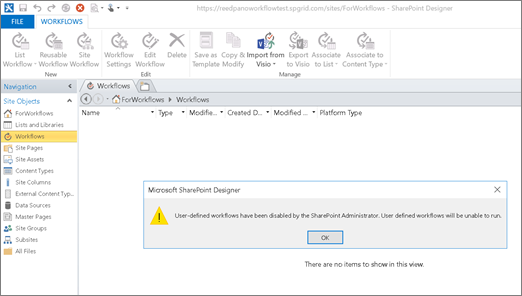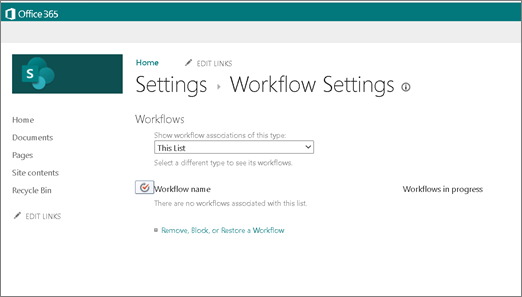Microsoft strives to deliver utmost value to our customers through modern, optimized, secure solutions in this newly evolved world focused on digital transformation. As part of this evolution of Microsoft 365 solutions, we retired SharePoint 2010 workflow as of November 1, 2020. In continuation with this, we will be retiring SharePoint 2013 workflow and believe Microsoft 365 customers will be better served by modern workflow solutions.
SharePoint 2013 workflow will be turned off for new tenants as of April 2, 2024. It will be removed from existing tenants and will be fully retired as of April 2, 2026. This applies to all environments including Government Clouds and Department of Defense. If you are using SharePoint 2013 workflow, we recommend migrating to Power Automate or other supported workflow orchestration solutions such as those offered via our ISV’s and Partners. If your tenant is using a 3rd party workflow engine, you should also inquire if it has a dependency on SharePoint 2013 workflow and work through options to migrate to a future offering of the workflow engine. There will not be an option to extend SharePoint 2013 workflow beyond April 2, 2026.
Timeline
|
Date |
Action |
|---|---|
|
April 2, 2024 |
SharePoint 2013 workflows will be turned off for any newly created tenants. |
|
April 2, 2026 |
SharePoint 2013 workflow will be removed from existing tenants. |
Overview
SharePoint 2013 workflows
In the context of SharePoint, a workflow is the automated movement of documents or items through a sequence of actions or tasks that are related to a business process. An organization can use workflows to attach business logic to documents or items in a SharePoint list or library.
Most customers use SharePoint Designer to author and publish workflows in SharePoint while professional developers looking to extend and build workflows use Visual Studio to build and publish workflows in SharePoint. Partner ISVs also have used this capability to leverage SharePoint 2013 workflow as an underlying orchestration platform.
Since the release of SharePoint 2013 workflow, Microsoft has evolved workflow orchestration to not only encompass SharePoint, but all the productivity services you use with Microsoft 365 and extend to 3rd parties. Power Automate is the Microsoft solution for workflow orchestration. It connects to all Microsoft 365 services and over 700 other services to let an enterprise build custom workflows. There are also many 3rd party solutions that can directly orchestrate SharePoint data via SharePoint’s open API platform.
SharePoint Server support for SharePoint 2010 and SharePoint 2013 workflows
SharePoint Server 2016 and SharePoint Server 2019 will continue to support SharePoint 2010- and SharePoint 2013-based workflows until those products reach their respective end of support dates. SharePoint Server Subscription Edition will support SharePoint 2010-based workflows until July 14, 2026, while SharePoint 2013-based workflows will remain supported beyond that date. For more information about the future of SharePoint 2013 workflow for SharePoint Server Subscription Edition, see Announcing the release of SharePoint Workflow Manager for SharePoint Server.
SharePoint Designer 2013
SharePoint 2013 workflow creation and execution against SharePoint Online from SharePoint Designer 2013 will be turned off for any newly created tenants starting April 2, 2024 and for existing tenants starting April 2, 2026. Existing workflows can only be viewed as raw XML files once SharePoint 2013 workflow has been turned off.
SharePoint Designer 2013 will work with on-premises SharePoint 2016, SharePoint 2019 and SharePoint Server Subscription Edition platforms for the remainder of the client support lifecycle (July 2026). SharePoint Designer 2013 will not be supported beyond that timeframe.
Call to Action Guidance
Microsoft 365 Assessment tool
To understand if your organization is using SharePoint 2013 workflow or begin planning migration to Power Automate or other 3rd party orchestration tools, we recommend that customers run the Microsoft 365 Assessment tool to scan their tenants for SharePoint 2013 workflows usage. Using the Power BI Workflow Report generated by the scanner tool, you can:
-
Identify all SharePoint 2013 workflows in the tenant, per site collection and site
-
Evaluate the recency and volume of usage of SharePoint 2013 workflows
-
Lists, libraries and content types that use SharePoint 2013 workflows
-
Power Automate upgradability score indicating if the detected actions in the SharePoint 2013 workflows are upgradable to flows with Power Automate
Using the Workflow Report along with site information, tenant administrators can plan the migration of SharePoint 2013 workflows with minimal impact to the users.
Turn off creation of new SharePoint 2013 workflows on your tenant
We recommend tenant administrators turn off creation of new SharePoint 2013 workflows using the following PowerShell command. Administrators should do this once you have confirmed there is no business need to allow new workflows to be created and that other applications are not creating workflows. The assessment tool should give administrators the usage information to understand where and when workflows are being created.
Connect-SPOService -Url https://<tenant>-admin.sharepoint.com
Set-SPOTenant -StopNew2013Workflows $true
Existing SharePoint 2013 workflows will continue to function and be editable. You can use the same command to re-enable the creation of SharePoint 2013 workflows if required. However, Microsoft recommends choosing a modern workflow orchestration solution instead.
User interface updates when SharePoint 2013 workflow is disabled on a tenant
When SharePoint 2013 workflow is disabled on a tenant, both SharePoint sites and SharePoint Designer will limit operations when trying to create or interact with a SharePoint 2013 workflow. Below are some of the known issues users can encounter in a tenant where SharePoint 2013 workflow is disabled.
-
Any time someone opens a site in SharePoint Designer and tries to perform an action related to SharePoint 2013 workflow (for example, create a new SharePoint 2013 workflow), they'll get the following error:
"User-defined workflows have been disabled by the SharePoint Administrator. User defined workflows will be unable to run."

-
When site collection owners activate the Workflows feature in Site Collection Features in a tenant where SharePoint 2013 workflows is disabled, the feature will successfully activate but users will be unable to create a workflow based on SharePoint 2013 workflow.
Users will be able to verify this behavior on the Workflow Settings page shown below.
How do I get help?
You can use the following services and partner programs to help with your migration from SharePoint 2013 workflows:
-
Help on SharePoint Assessment tool: Open a support ticket
More information
Blog announcement for workflow update
A Message Center post in the Microsoft 365 admin center is being sent to all tenants, and the post will be updated periodically with timelines.










